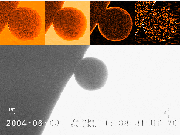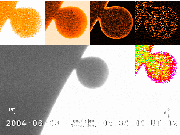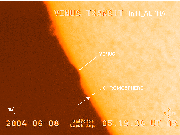 |
|




The Venus
Transit 2004
... Photos (541-550)
On this and the other pages in the VT-2004 Photo Archive,
photos are displayed which are related to Venus, the Sun and/or the
Venus Transit. They were obtained in many different places. Some of
these photos were elected "VT 2004 Photo of
the Day".
All photos on this page may be downloaded and used, provided the
photographers (authors) and the VT-2004 programme are indicated as
source.
 |
|
|
[Previous page]
Page 55
[Next page]
|
|
 |
|
Processed Images Illustrating Black Drop Phenomenon
The images on this page serve to illustrate the "Black Drop"
effect. The images were obtained at the Ondrejov observatory (Czech
Republic) in white light (images 1 - 4; South is towards the top) and
through an H-alpha filter (images 5 - 8; South is down).
The image processing was performed by Stanislava Simberova,
by means of the procedures available to everybody via the VT-2004 Image Processing
Pages
|
|
|

Black Drop Phenomenon (1)
[603 x 451 - 89k]
Stanislava Simberova
Ondrejov Observatory
June 8, 2004, 05:38:31:08 UT
Ondrejov, Czech Republic
|

Black Drop Phenomenon (2)
[603 x 451 - 88k]
Stanislava Simberova
Ondrejov Observatory
June 8, 2004, 05:38:31:20 UT
Ondrejov, Czech Republic
|
|
|

Black Drop Phenomenon (3)
[603 x 451 - 85k]
Stanislava Simberova
Ondrejov Observatory
June 8, 2004, 05:38:34:23 UT
Ondrejov, Czech Republic
|

Black Drop Phenomenon (4)
[603 x 451 - 112k]
Stanislava Simberova
Ondrejov Observatory
June 8, 2004, 05:39:09:02 UT
Ondrejov, Czech Republic
|
|
|
Photos 1 - 4 show the effect at the moment of the second
contact and the development in time. In each of these photos, the
lower image (in B/W) is the observed, original (raw) one. In the
upper part, there are four processed images (A, B, C and D from left
to right), based on the original one. They were prepared by using
different processing techniques.
Images A and B: Edge crispening. They were made by discrete
convolution with high-pass form of the impulse response H(A),
H(B).
Image C: Edge detection. Edges characterize object
boundaries and are therefore useful for segmentation, registration,
and identification of objects within scenes. Typically, edge, line and
spot locations are specified by darker pixels against a lighter
background. This is exactly the case during the Venus transit across
over the bright surface on the Sun. These techniques are based on the
first-order derivative and involve the generation of gradients in two
orthogonal directions in an image. The row and column gradients
involve a linear combination of pixels within a small
neighborhood. For these images, a Sobel filter was applied.
D: Edge detection. This method is based on the second
derivative. An edge is marked if a significant spatial change occurs
in the second derivative. It was performed by a Laplace filter.
The fourth image has an insert in which the image was transformed
by discrete high-pass convolution and displayed using the isophot
transformation table. The colours in the image corresponds to the
exact density ranges.
|
|
 |
|
|

Black Drop Phenomenon (5)
[603 x 451 - 184k]
Stanislava Simberova
Ondrejov Observatory
June 8, 2004, 05:19:38:05 UT
Ondrejov, Czech Republic
|

Black Drop Phenomenon (6)
[603 x 451 - 192k]
Stanislava Simberova
Ondrejov Observatory
June 8, 2004, 05:19:38:05 UT
Ondrejov, Czech Republic
|
|
|
Photos 5 and 6 display H_alpha (wavelength 656.3 nm) images
of the solar chromosphere, obtained just before the 1st contact. Photo
5 is a reproduction of the original image, with the different features
designated. Photo 6 is the same image, but now with an insert image
that has been processed: noise cleaning by means of a special
smoothing filter and non-linear contrast manipulation function
application.
|
|
|

Black Drop Phenomenon (7)
[603 x 451 - 192k]
Stanislava Simberova
Ondrejov Observatory
June 8, 2004, 05:37:48:22 UT
Ondrejov, Czech Republic
|

Black Drop Phenomenon (8)
[452 x 452 - 88k]
Stanislava Simberova
Ondrejov Observatory
June 8, 2004, 05:38:34:23 UT
Ondrejov, Czech Republic
|
|
|
Photo 7 shows the situation just before the 2nd contact; on
the original image, the photosphere "border" is indicated with a
traced line. Photo 8 is an enlargement from Photo 7, with the
point of the 2nd contact at the level of the photosphere marked.
|
|
|
 |
|
|
[Previous page]
[Next page]
|
|
|


